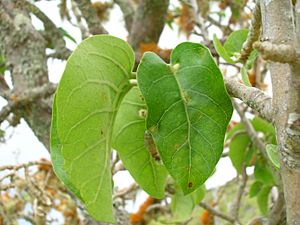Nothocestrum facts for kids
Quick facts for kids Nothocestrum |
|
|---|---|
 |
|
| Broadleaf ʻaiea (Nothocestrum latifolium) |
|
| Scientific classification |
|
| Kingdom: | Plantae |
| Clade: | Tracheophytes |
| Clade: | Angiosperms |
| Clade: | Eudicots |
| Clade: | Asterids |
| Order: | Solanales |
| Family: | Solanaceae |
| Subfamily: | Solanoideae |
| Tribe: | Physaleae |
| Genus: | Nothocestrum A.Gray |
| Species | |
|
See text |
|
Nothocestrum is a special group of flowering plants. They belong to the nightshade family, just like tomatoes and potatoes! These plants are large shrubs or small trees.
You can only find Nothocestrum plants in Hawaii. This means they are endemic to Hawaii. When a plant or animal is endemic, it lives naturally in only one place in the world. In Hawaii, these plants are known by their local name, ʻaiea.
Meet the 'Aiea Species
There are four known types, or species, of ʻaiea plants. Each one has its own unique features and can be found on different Hawaiian islands.
- Nothocestrum breviflorum – This is the Smallflower ʻaiea. You can find it on the island of Hawaiʻi.
- Nothocestrum latifolium – This one is called the Broadleaf ʻaiea. It grows on several islands: Maui, Molokaʻi, Lānaʻi, Oʻahu, and Kauaʻi.
- Nothocestrum longifolium – This is the Longleaf ʻaiea. It's found on the island of Hawaiʻi, Maui, Molokaʻi, Lānaʻi, Oʻahu, and Kauaʻi.
- Nothocestrum peltatum – This species is the Oʻahu ʻaiea. Despite its name, it is found on Kauaʻi.
Traditional Uses of 'Aiea
Long ago, people in Hawaii used parts of the ʻaiea plant for traditional medicine. They used the leaves, bark, and roots.
They would pound these plant parts and mix them with water. This mixture was then strained and heated with hot rocks. After cooling, it was applied to the skin. This was done to help treat skin problems like abscesses.
The same plant parts were also made into a liquid medicine. This liquid was taken by mouth to help with abscesses from the inside. This special medicine often included other plants too. These included ohiʻa bark (from Metrosideros trees), moa holo kula (a fern called Psilotum nudum), and red or purple sugarcane (Saccharum officinarum).

